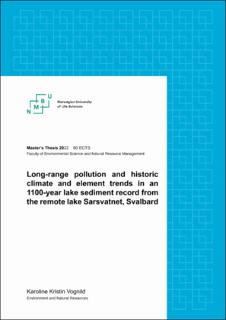| dc.contributor.advisor | Rohrlack, Thomas | |
| dc.contributor.advisor | Riise, Gunnhild | |
| dc.contributor.advisor | Mikkelsen, Øyvind | |
| dc.contributor.author | Vognild, Karoline Kristin | |
| dc.coverage.spatial | Norway, Svalbard | en_US |
| dc.date.accessioned | 2022-12-19T08:14:26Z | |
| dc.date.available | 2022-12-19T08:14:26Z | |
| dc.date.issued | 2022 | |
| dc.identifier.uri | https://hdl.handle.net/11250/3038376 | |
| dc.description.abstract | Although remote, the Arctic is influenced by long-range pollution from lower latitudes. Lake sediments are sensitive to minor environmental changes, and thus accumulated heavy metals and organic substitutes can represent the concentration trends through time and as a climate proxy. To assess the extent of long-range pollution influence in Lake Sarsvatnet, Svalbard, and the different forcing mechanisms in the catchment, chlorophyll a, Loss on Ignition (LOI), and selected heavy metals were analysed from a sediment core. Selected elements are aluminium (Al), arsenic (As), cadmium (Cd), calcium (Ca), chromium (Cr), copper (Cu), iron (Fe), lead (Pb), magnesium (Mg), manganese (Mn), nickel (Ni), phosphorus (P), potassium (K), sodium (Na), sulphur (S), titanium (Ti), and zinc (Zn). Results indicate that Cd in the sediment surface is derived from bird guano and atmospheric deposition from long-range pollution. A contribution of Pb concentrations in the sediment surface may originate from atmospheric deposition, however, more research is needed as geological processes likely contribute most of the Pb content in Sarsvatnet.
Climate proxies (LOI and Chlorophyll a) demonstrated historical periods e.g., the Little Ice Age and Medieval Climate Anomaly. Although variations over the last 1100 years, increased primary production and elemental concentrations in the last century are major findings identified in this thesis. With rising temperatures, precipitation, and bedrock weathering, it is fair to expect an alternation of elements, primary production residues, and soil organic matter in the Sarsvatnet catchment in the future. In other words, climate change has a more significant impact on the composition of the sediments in Sarsvatnet than long-range pollution.
This master’s thesis provides an updated evaluation of the status quo in Sarsvatnet catchment and could be relevant to further investigations at Ossian Sars. | en_US |
| dc.description.abstract | Til tross for at arktiske områder er avsidesliggende, er Arktis påvirket av langtransportert forurensning fra lavere breddegrad. Innsjøsedimenter er sensitiv for små miljøforandringer, dermed kan akkumulerte grunnstoff og organiske substanser benyttes til å vurdere konsentrasjonstrender gjennom tiden og for å indikere tidligere klima. Klorofyll a, glødetap (LOI) og valgte grunnstoff fra en sedimentkjerne ble anvendt for å vurdere grad av langtransportert forurensning i Sarsvatnet, Svalbard, samt naturlige mekanismer i nedbørsfeltet. Valgte grunnstoff er aluminium (Al), arsen (As), bly (Pb), fosfor (P), jern (Fe), kadmium (Cd), kalium (K), kalsium (Ca), kobber (Cu), krom (Cr), magnesium (Mg), mangan (Mn), natrium (Na), nikkel (Ni), sink (Zn), svovel (S), og titan (Ti). Resultatene indikerer at fugleekskrementer og atmosfærisk avsetting fra langtransportert forurensning kan være kilder til oppkonsentrert kadmium i det øverste sedimentlaget. En del av blykonsentrasjonen i det øverste sedimentlaget kan stamme fra atmosfærisk avsetting. Mer forskning er nødvendig, siden geologiske prosesser bidrar med mesteparten av blykonsentrasjonen i Sarsvatnet.
Klimaindikatorer (klorofyll a og glødetap) har identifisert historiske perioder, som Den lille istid og den Middelalderske varmeperioden. Et av hovedfunnene var økt primærproduksjon og økte grunnstoffkonsentrasjoner det siste århundre til tross for varierende konsentrasjoner de siste 1100 årene. Likevel antyder resultatene en endring i bakgrunnsverdier grunnet økt nedbør og forvitring av lokal berggrunn i det siste århundret. Klimaendringer har dermed større påvirkning på grunnstoffkonsentrasjonen enn langtransportert forurensning i innsjøsedimenter i Sarsvatnet.
Denne masteroppgaven gir oppdatert vurdering av status quo i Sarsvatnet, og kan være relevant ved videre arbeid på Ossian Sars. | en_US |
| dc.language.iso | eng | en_US |
| dc.publisher | Norwegian University of Life Sciences, Ås | en_US |
| dc.rights | Attribution-NonCommercial-NoDerivatives 4.0 Internasjonal | * |
| dc.rights.uri | http://creativecommons.org/licenses/by-nc-nd/4.0/deed.no | * |
| dc.subject | Long-range pollution | en_US |
| dc.subject | Climate proxies | en_US |
| dc.subject | Sediment record | en_US |
| dc.subject | Sarsvatnet | en_US |
| dc.title | Long-range pollution and historic climate and element trends in an 1100-year lake sediment record from the remote lake Sarsvatnet, Svalbard | en_US |
| dc.type | Master thesis | en_US |
| dc.description.localcode | M-MINA | en_US |

